The alu-alu packaging market, forecast to expand from USD 2,712.7 million to USD 4,460.9 million, illustrates how shifts in packaging trends directly influence valuation over the decade. Growth of 64% in the first five years and 94% by 2035 is linked to clear patterns in technology adoption, compliance, and consumer preferences. One top trend is the rise of enhanced barrier systems, particularly moisture- and oxygen-resistant laminates. These features, once positioned as premium, are now embedded as standard, ensuring consistent adoption across global pharmaceutical supply chains. This movement influences market value by accelerating early adoption, adding USD 597.1 million in the first half of the forecast window, as hospitals and pharmaceutical companies standardize alu-alu for high-sensitivity drugs.
Another trend is the integration of tamper-evidence and anti-counterfeit features. Drug security is a regulatory priority, and alu-alu packs offer compatibility with serialization, holography, and track-and-trace systems. This has shifted procurement from cost-centric to compliance-centric buying, boosting valuation steadily in developed regions where regulatory enforcement is strong. By the latter half of the period, smart packaging technologies, including embedded codes, sensors, and interactive features, are expected to influence demand further. Pharmaceutical companies seek to integrate packaging into digital health ecosystems, making alu-alu formats part of supply chain visibility platforms. This adoption wave is projected to add USD 1,151.1 million in incremental revenue, accounting for 58% of the decade-long expansion and elevating the overall market size to USD 4,460.9 million.
Regional adoption trends also feed into valuation growth. Europe and North America drive early increases due to compliance with strict drug safety rules, while Asia Pacific contributes larger volumes in the second half as pharmaceutical manufacturing expands and governments enforce tighter quality standards. Latin America and the Middle East will gradually participate as the healthcare infrastructure strengthens, adding incremental gains.
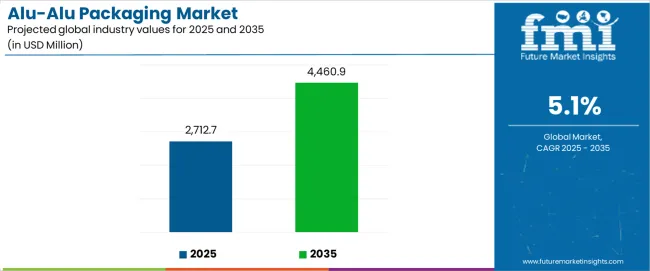
| Period | Primary Revenue Buckets | Share | Notes |
|---|---|---|---|
| Today | Blister packs for pharmaceuticals | 52% | Traditional drug packaging, established pharma companies |
| Strip packs for tablets/capsules | 31% | Unit dose applications, hospital markets | |
| Specialized medical packaging | 17% | High-value medications, controlled substances | |
| Future (3-5 yrs) | Advanced blister systems | 48-51% | Smart packaging, serialization integration |
| Multi-dose strip packs | 28-32% | Patient compliance, elderly care applications | |
| Pharmaceutical cold chain | 12-16% | Biologics, vaccines, temperature-sensitive drugs | |
| Cosmetics & personal care | 8-12% | Premium beauty products, dermatological applications | |
| Nutraceutical packaging | 6-10% | Supplements, functional foods, wellness products | |
| Medical device packaging | 4-8% | Sterile barriers, implantable devices, diagnostics |
At-a-Glance Metrics
| Metric | Value |
|---|---|
| Market Value (2025) | USD 2,712.7 million |
| Market Forecast (2035) | USD 4,460.9 million |
| Growth Rate | 5.1% CAGR |
| Leading Type | Blister Packs |
| Primary Application | Pharmaceutical Products |
The alu-alu packaging market exhibits strong fundamentals, with blister pack systems capturing a dominant share due to their advanced barrier properties and optimized pharmaceutical applications. Pharmaceutical applications drive primary demand, supported by growing drug safety requirements and modernization initiatives within the healthcare industry. Geographic expansion remains concentrated in developed markets with established pharmaceutical infrastructure, while emerging economies show accelerating adoption rates driven by healthcare industry modernization initiatives and rising medication safety standards.
Primary Classification: The market segments by type into blister packs, strip packs, and others, representing the evolution from traditional pharmaceutical packaging to sophisticated multi-layer barrier systems for comprehensive medication protection optimization.
Secondary Classification: Application segmentation divides the alu-alu packaging market into pharmaceutical products, cosmetics products, and others, reflecting distinct requirements for barrier performance, regulatory standards, and product protection specifications.
Tertiary Classification: End-use segmentation covers pharmaceutical companies, cosmetics manufacturers, nutraceutical producers, medical device companies, and contract packaging organizations, while distribution channels span direct sales, packaging distributors, and specialized pharmaceutical suppliers.
Regional Classification: Geographic distribution covers North America, Latin America, Western Europe, Eastern Europe, East Asia, South Asia Pacific, and Middle East & Africa, with developed markets leading adoption while emerging economies show accelerating growth patterns driven by pharmaceutical industry modernization programs.
The segmentation structure reveals packaging progression from traditional aluminum-aluminum barriers toward sophisticated multi-functional systems with enhanced protection capabilities, while application diversity spans from prescription medications to premium cosmetics requiring precision barrier solutions.
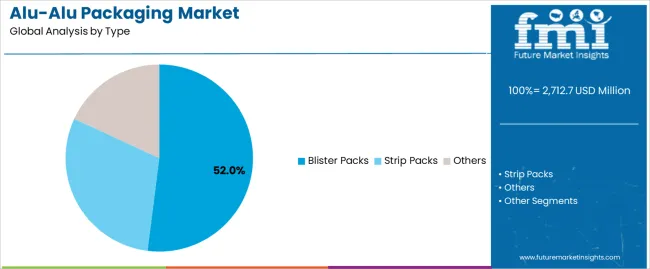
Market Position: Blister pack systems command the leading position in the alu-alu packaging market with 52% market share through proven barrier technologies, including moisture protection, tamper evidence, and pharmaceutical compliance optimization that enable drug manufacturers to achieve optimal medication safety across diverse pharmaceutical and healthcare environments.
Value Drivers: The segment benefits from pharmaceutical industry preference for validated packaging systems that provide superior barrier protection, regulatory compliance, and product integrity without requiring complex packaging infrastructure. Advanced blister processing features enable enhanced child resistance, easy opening properties, and integration with existing pharmaceutical production lines, where barrier performance and regulatory compliance represent critical operational requirements.
Competitive Advantages: Blister pack systems differentiate through proven barrier reliability, pharmaceutical compatibility, and integration with established quality management systems that enhance facility effectiveness while maintaining optimal safety standards suitable for diverse medication applications.
Key market characteristics:
Strip pack systems maintain a 31% market position in the alu-alu packaging market due to their unit-dose advantages and patient compliance benefits. These formats appeal to facilities requiring efficient medication dispensing with enhanced dosage control profiles for hospital operations. Market growth is driven by healthcare facility expansion, emphasizing patient safety solutions and medication management through optimized dispensing designs.
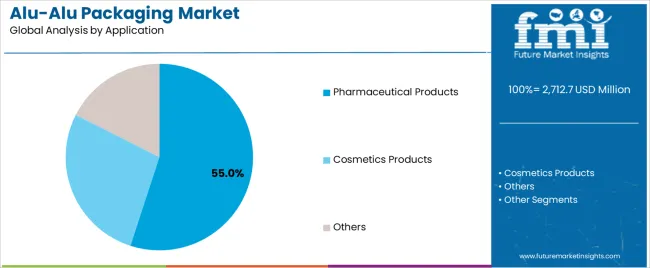
Market Context: Pharmaceutical applications demonstrate strong growth in the alu-alu packaging market with 55% market share due to widespread adoption of advanced barrier packaging programs and increasing focus on medication safety, regulatory compliance, and patient protection applications that maximize packaging effectiveness while maintaining pharmaceutical standards.
Appeal Factors: Pharmaceutical companies prioritize packaging reliability, regulatory consistency, and integration with existing pharmaceutical infrastructure that enables coordinated packaging operations across multiple drug manufacturing departments. The segment benefits from substantial pharmaceutical industry investment and modernization programs that emphasize the acquisition of premium packaging systems for product differentiation and patient safety applications.
Growth Drivers: Pharmaceutical expansion programs incorporate alu-alu packaging as essential components for drug protection, while specialty medication growth increases demand for packaging capabilities that comply with regulatory standards and minimize contamination risks.
Market Challenges: Varying regulatory requirements and production scale complexity may limit packaging standardization across different medications or therapeutic scenarios.
Application dynamics include:
Cosmetics applications capture 24% market share through specialized protection requirements in premium beauty products, dermatological treatments, and personal care applications. These facilities demand advanced packaging capable of supporting brand requirements while providing product protection access and shelf-life optimization capabilities.
Market Context: Pharmaceutical Companies dominate the alu-alu packaging market with a 5.8% CAGR, reflecting the primary demand source for alu-alu packaging technology in drug manufacturing applications and regulatory standardization.
Business Model Advantages: Pharmaceutical Companies provide direct market demand for validated packaging systems, driving volume production and cost optimization while maintaining quality control and regulatory compliance requirements.
Operational Benefits: Pharmaceutical Company applications include regulatory standardization, cost efficiency, and quality assurance that drive consistent demand for packaging systems while providing access to latest barrier technologies.
| Category | Factor | Impact | Why It Matters |
|---|---|---|---|
| Driver | Pharmaceutical industry growth & drug development expansion (new medications, biologics growth) | ★★★★★ | Growing pharmaceutical market requires advanced packaging with enhanced barrier capabilities and regulatory compliance properties proven effective across medication applications. |
| Driver | Regulatory standards advancement & safety requirements (drug safety, serialization mandates) | ★★★★★ | Transforms packaging requirements from "basic protection" to "comprehensive safety system"; companies that offer compliant packaging and traceability features gain competitive advantage. |
| Driver | Aging population & chronic disease growth (medication compliance, elderly care) | ★★★★☆ | Aging demographics need convenient, safe packaging; demand for patient-friendly and compliance-oriented packaging solutions expanding addressable market. |
| Restraint | Raw material cost pressures & aluminum price volatility (commodity pricing, supply chain disruptions) | ★★★★☆ | Smaller pharmaceutical companies defer packaging upgrades; increases price sensitivity and slows premium packaging adoption in cost-conscious markets. |
| Restraint | Alternative packaging competition (plastic alternatives, sustainable options) | ★★★☆☆ | Non-aluminum alternatives offer environmental benefits and established supply chains, potentially limiting alu-alu adoption in traditional applications. |
| Trend | Smart packaging integration & serialization enhancement (track-and-trace, anti-counterfeiting) | ★★★★★ | Advanced serialization capabilities, tamper evidence, and anti-counterfeiting analytics transform operations; technology integration and compliance enhancement become core value propositions. |
| Trend | Cold chain packaging & temperature-sensitive solutions (biologics, vaccines) | ★★★★☆ | Specialized packaging for temperature-sensitive products; advanced barrier designs and cold chain capabilities drive competition toward specialized solutions. |
The alu-alu packaging market demonstrates varied regional dynamics with Growth Leaders including China (6.9% growth rate) and India (6.4% growth rate) driving expansion through pharmaceutical development initiatives and healthcare industry modernization.
Steady Performers encompass Germany (5.9% growth rate), Brazil (5.4% growth rate), and developed regions, benefiting from established pharmaceutical industries and advanced packaging adoption. Mature Markets feature United States (4.8% growth rate), United Kingdom (4.3% growth rate), and Japan (3.8% growth rate), where pharmaceutical advancement and regulatory standardization requirements support consistent growth patterns.
Regional synthesis reveals East Asian markets leading adoption through pharmaceutical expansion and healthcare development, while North American countries maintain steady expansion supported by packaging technology advancement and regulatory standardization requirements. European markets show strong growth driven by pharmaceutical applications and quality integration trends.
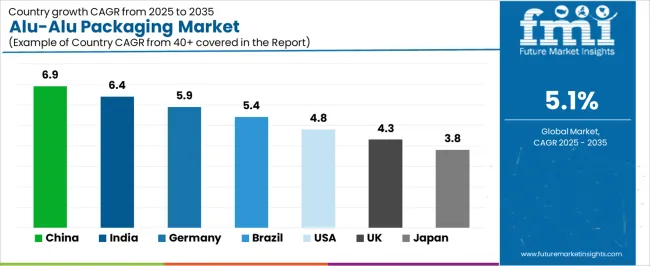
| Region/Country | 2025 to 2035 Growth | How to win | What to watch out |
|---|---|---|---|
| China | 6.9% | Focus on pharmaceutical manufacturing solutions | Regulatory changes; local competition |
| India | 6.4% | Lead with cost-effective manufacturing | Import restrictions; quality barriers |
| Germany | 5.9% | Provide premium quality packaging | Over-regulation; lengthy approvals |
| Brazil | 5.4% | Offer value-oriented solutions | Currency fluctuations; import duties |
| United States | 4.8% | Push technology integration | Compliance costs; scaling challenges |
| United Kingdom | 4.3% | Focus on premium applications | Economic impacts; packaging costs |
| Japan | 3.8% | Emphasize quality manufacturing | Traditional preferences; adoption rates |
China establishes fastest market growth through aggressive pharmaceutical development programs and comprehensive healthcare industry expansion, integrating advanced alu-alu packaging systems as standard components in drug manufacturing facilities and pharmaceutical installations. The country's 6.9% growth rate reflects government initiatives promoting pharmaceutical infrastructure and domestic packaging capabilities that mandate the use of advanced barrier systems in pharmaceutical and healthcare facilities. Growth concentrates in major pharmaceutical hubs, including Beijing, Shanghai, and Guangzhou, where pharmaceutical development showcases integrated packaging systems that appeal to drug manufacturers seeking product protection optimization capabilities and regulatory applications.
Chinese manufacturers are developing cost-effective packaging solutions that combine domestic production advantages with advanced barrier features, including enhanced moisture control and improved tamper evidence capabilities. Distribution channels through pharmaceutical suppliers and packaging distributors expand market access, while government support for pharmaceutical development supports adoption across diverse medication and healthcare segments.
Strategic Market Indicators:
In Mumbai, Delhi, and Bangalore, pharmaceutical facilities and drug manufacturers are implementing professional alu-alu packaging systems as standard equipment for medication protection and regulatory optimization applications, driven by increasing government healthcare investment and pharmaceutical modernization programs that emphasize the importance of product safety capabilities. The alu-alu packaging market holds a 6.4% growth rate, supported by government pharmaceutical initiatives and healthcare development programs that promote advanced packaging systems for pharmaceutical and medical facilities. Indian operators are adopting packaging systems that provide consistent product protection and compliance features, particularly appealing in urban regions where medication safety and regulatory excellence represent critical business requirements.
Market expansion benefits from growing pharmaceutical capabilities and international healthcare partnerships that enable domestic production of advanced packaging systems for pharmaceutical and medical applications. Technology adoption follows patterns established in pharmaceutical equipment, where reliability and compliance drive procurement decisions and operational deployment.
Market Intelligence Brief:
Germany's advanced pharmaceutical market demonstrates sophisticated alu-alu packaging deployment with documented protection effectiveness in pharmaceutical applications and healthcare facilities through integration with existing pharmaceutical systems and operational infrastructure. The country leverages engineering expertise in materials and quality systems integration to maintain a 5.9% growth rate. Pharmaceutical centers, including Bavaria, Baden-Württemberg, and North Rhine-Westphalia, showcase premium installations where packaging systems integrate with comprehensive pharmaceutical platforms and facility management systems to optimize product protection and operational effectiveness.
German manufacturers prioritize system quality and EU compliance in packaging development, creating demand for premium systems with advanced features, including facility integration and pharmaceutical protection systems. The alu-alu packaging market benefits from established pharmaceutical infrastructure and a willingness to invest in advanced packaging technologies that provide long-term operational benefits and compliance with international pharmaceutical standards.
Market Intelligence Brief:
Brazil's market expansion benefits from diverse pharmaceutical demand, including healthcare modernization in São Paulo and Rio de Janeiro, pharmaceutical facility upgrades, and government healthcare programs that increasingly incorporate advanced packaging solutions for medication applications. The country maintains a 5.4% growth rate, driven by rising pharmaceutical activity and increasing recognition of advanced packaging benefits, including precise protection control and enhanced regulatory effectiveness.
Market dynamics focus on cost-effective packaging solutions that balance product protection performance with affordability considerations important to Brazilian pharmaceutical operators. Growing pharmaceutical industrialization creates continued demand for modern packaging systems in new pharmaceutical infrastructure and facility modernization projects.
Strategic Market Considerations:
United States establishes market leadership through comprehensive pharmaceutical programs and advanced healthcare infrastructure development, integrating alu-alu packaging systems across pharmaceutical and medical applications. The country's 4.8% growth rate reflects established pharmaceutical industry relationships and mature packaging technology adoption that supports widespread use of advanced packaging systems in pharmaceutical and healthcare facilities. Growth concentrates in major pharmaceutical centers, including California, New Jersey, and Massachusetts, where packaging technology showcases mature deployment that appeals to pharmaceutical operators seeking proven protection capabilities and regulatory compliance applications.
American pharmaceutical providers leverage established distribution networks and comprehensive technical support capabilities, including validation programs and training support that create customer relationships and operational advantages. The alu-alu packaging market benefits from mature regulatory standards and pharmaceutical requirements that mandate packaging system use while supporting technology advancement and operational optimization.
Market Intelligence Brief:
United Kingdom's pharmaceutical market demonstrates integrated alu-alu packaging deployment with documented protection effectiveness in pharmaceutical applications and healthcare facilities through integration with existing pharmaceutical systems and operational infrastructure. The country maintains a 4.3% growth rate, supported by pharmaceutical excellence programs and protection effectiveness requirements that promote advanced packaging systems for pharmaceutical applications. Pharmaceutical facilities across England, Scotland, and Wales showcase systematic installations where packaging systems integrate with comprehensive pharmaceutical platforms to optimize product protection and operational outcomes.
UK pharmaceutical providers prioritize system reliability and industry compatibility in packaging procurement, creating demand for validated systems with proven protection features, including quality monitoring integration and pharmaceutical compliance systems. The alu-alu packaging market benefits from an established pharmaceutical infrastructure and high standards that support the adoption of packaging technology and operational effectiveness.
Market Intelligence Brief:
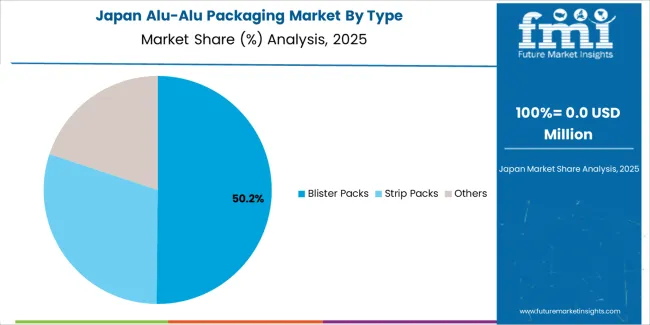
Japan's market growth benefits from precision pharmaceutical demand, including advanced pharmaceutical facilities in Tokyo and Osaka, quality integration, and healthcare enhancement programs that increasingly incorporate packaging solutions for protection applications. The country maintains a 3.8% growth rate, driven by pharmaceutical technology advancement and increasing recognition of precision packaging benefits, including accurate protection control and enhanced healthcare outcomes.
Market dynamics focus on high-precision packaging solutions that meet Japanese quality standards and protection effectiveness requirements important to pharmaceutical operators. Advanced pharmaceutical technology adoption creates continued demand for sophisticated packaging systems in pharmaceutical facility infrastructure and healthcare modernization projects.
Strategic Market Considerations:
The European alu-alu packaging market is projected to grow from USD 596.8 million in 2025 to USD 982.1 million by 2035, registering a CAGR of 5.1% over the forecast period. Germany is expected to maintain its leadership position with a 42.1% market share in 2025, supported by its advanced pharmaceutical infrastructure and major manufacturing centers.
United Kingdom follows with a 28.3% share in 2025, driven by comprehensive pharmaceutical programs and healthcare excellence development initiatives. France holds a 16.2% share through specialized pharmaceutical applications and regulatory compliance requirements. Italy commands a 8.7% share, while Spain accounts for 4.7% in 2025. The rest of Europe region is anticipated to gain momentum, expanding its collective share from 2.8% to 3.2% by 2035, attributed to increasing pharmaceutical adoption in Nordic countries and emerging healthcare facilities implementing pharmaceutical modernization programs.
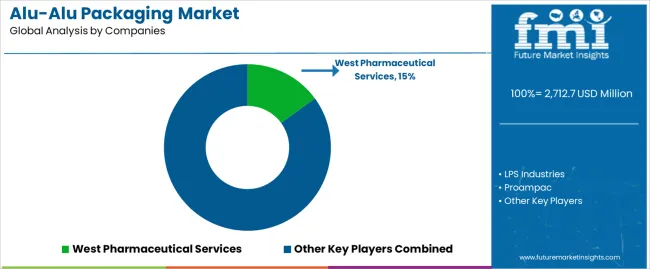
| Stakeholder | What they actually control | Typical strengths | Typical blind spots |
|---|---|---|---|
| Global brands | Distribution reach, broad product catalogs, regulatory expertise | Wide availability, proven compliance, multi-region support | Product refresh cycles; customer dependency on brand validation |
| Technology innovators | Barrier R&D; advanced material technologies; enhanced protection properties | Latest technologies first; attractive ROI on performance effectiveness | Service density outside core regions; scaling complexity |
| Regional specialists | Local compliance, fast delivery, nearby customer support | "Close to customer" support; pragmatic pricing; local regulations | Technology gaps; talent retention in customer service |
| Full-service providers | Packaging programs, validation services, quality management | Lowest operational risk; comprehensive support | Service costs if overpromised; technology obsolescence |
| Niche specialists | Specialized applications, custom packaging, regulatory services | Win premium applications; flexible configurations | Scalability limitations; narrow market focus |
| Item | Value |
|---|---|
| Quantitative Units | USD 2,712.7 million |
| Type | Blister Packs, Strip Packs, Others |
| Application | Pharmaceutical Products, Cosmetics Products, Others |
| End Use | Pharmaceutical Companies, Cosmetics Manufacturers, Nutraceutical Producers, Medical Device Companies, Contract Packaging Organizations |
| Regions Covered | North America, Latin America, Western Europe, Eastern Europe, East Asia, South Asia Pacific, Middle East & Africa |
| Countries Covered | China, India, Germany, Brazil, United States, United Kingdom, Japan, Canada, France, Australia, and 25+ additional countries |
| Key Companies Profiled | West Pharmaceutical Services, LPS Industries, Proampac, Gerresheimer, Essentra Packaging, Schott, Multivac, Sanner, Constantia Flexibles |
| Additional Attributes | Dollar sales by type and application categories, regional adoption trends across East Asia, North America, and Western Europe, competitive landscape with packaging manufacturers and pharmaceutical suppliers, pharmaceutical operator preferences for packaging effectiveness and product protection, integration with pharmaceutical platforms and quality management systems, innovations in barrier technology and packaging enhancement, and development of advanced packaging solutions with enhanced performance and operational optimization capabilities. |
The global alu-alu packaging market is estimated to be valued at USD 2,712.7 million in 2025.
The market size for the alu-alu packaging market is projected to reach USD 4,460.9 million by 2035.
The alu-alu packaging market is expected to grow at a 5.1% CAGR between 2025 and 2035.
The key product types in alu-alu packaging market are blister packs, strip packs and others.
In terms of application, pharmaceutical products segment to command 55.0% share in the alu-alu packaging market in 2025.






Full Research Suite comprises of:
Market outlook & trends analysis
Interviews & case studies
Strategic recommendations
Vendor profiles & capabilities analysis
5-year forecasts
8 regions and 60+ country-level data splits
Market segment data splits
12 months of continuous data updates
DELIVERED AS:
PDF EXCEL ONLINE
Packaging Barrier Film Market Size and Share Forecast Outlook 2025 to 2035
Packaging Films Market Size and Share Forecast Outlook 2025 to 2035
Packaging Laminate Market Size and Share Forecast Outlook 2025 to 2035
Packaging Burst Strength Test Market Size and Share Forecast Outlook 2025 to 2035
Packaging Tapes Market Analysis - Size, Share, & Forecast Outlook 2025 to 2035
Packaging Materials Market Size and Share Forecast Outlook 2025 to 2035
Packaging Labels Market Size and Share Forecast Outlook 2025 to 2035
Packaging Equipment Market Size and Share Forecast Outlook 2025 to 2035
Packaging Tubes Market Trends and Growth 2035
Packaging Resins Market Size and Share Forecast Outlook 2025 to 2035
Packaging Inspection Systems Market Size and Share Forecast Outlook 2025 to 2035
Packaging Design And Simulation Technology Market Size and Share Forecast Outlook 2025 to 2035
Packaging Suction Cups Market Size and Share Forecast Outlook 2025 to 2035
Packaging Straps and Buckles Market Size and Share Forecast Outlook 2025 to 2035
Packaging Coating Market Analysis - Size, Share, & Forecast Outlook 2025 to 2035
Packaging Testing Services Market Analysis - Size, Share, and Forecast 2025 to 2035
Packaging Testing Equipment Market Analysis & Growth 2025 to 2035
Packaging Bins Market Trends - Growth & Demand 2025 to 2035
Packaging Inserts Market Insights - Growth & Forecast 2025 to 2035
Packaging Tensioner Market Analysis - Growth & Forecast 2025 to 2035

Thank you!
You will receive an email from our Business Development Manager. Please be sure to check your SPAM/JUNK folder too.
Chat With
MaRIA